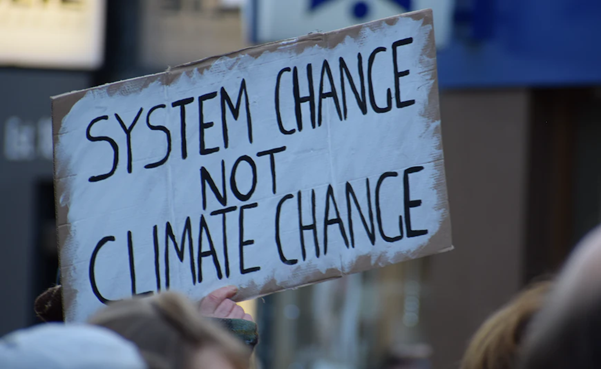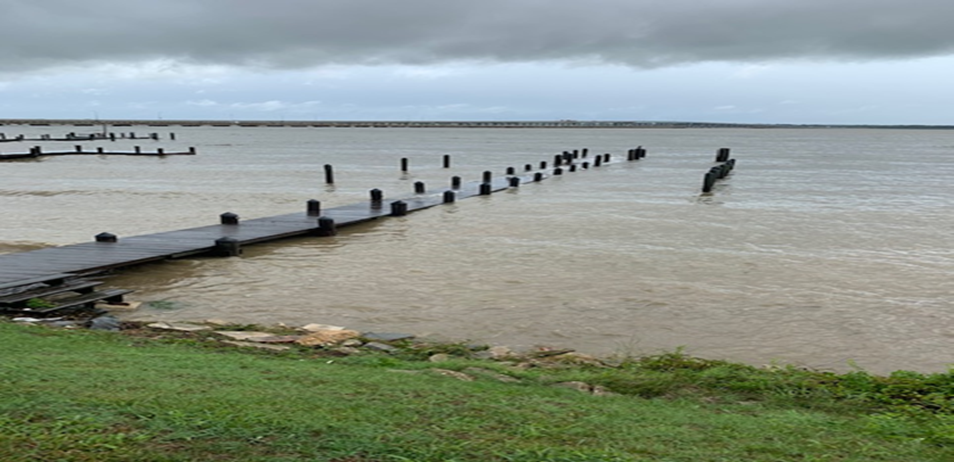Can scientists save the world?
Colin S. Vissering ·As doctorate students in a science-oriented program at the University of Maryland, we have the luxury of hyper-specialization. It is a marvelous thing to be able to focus on the depth of sediment necessary to allow for coastal marshes to migrate with sea level rise, or the density of mangroves required to attenuate wave damage along coastlines. Are we solving the real environmental and ecological problems of the world with such focused approaches? Should we be?

A view of hurricane damage along the coastline, showing the devastation to structures such as piers along the water. "Hurricane Damage" by Loco Steve is licensed under CC BY 2.0.
Over the past few weeks, we have been collectively watching images of the devastating impacts of Hurricane Ian on the southwest coast of Florida. American society seems well past the point of arguing that the climate is changing and impacting our planet, even if we do not yet all agree “why” it is changing. The contractor fixing up my old barn was just telling me the other day that he remembers when they would race ice boats on the local rivers every winter on the Eastern Shore. I do not think I have seen ice on the Choptank River in the six years I have lived on this side of the Bay, and I hear “old-timers” talking about how we do not have real winters here anymore.
We all know hurricanes are certainly nothing new, but the increase in the temperatures of ocean water around the world has led to an unprecedented intensification of storms which, when mixed with the massive new developments along high-risk coastlines, has led to increasingly greater impacts to the built environment and vulnerable populations.
Scientists have certainly played a key role in identifying and measuring the factors related to climate change and sea level rise (and the corresponding intensification of weather events), but the accepted and continued approach of hyper-specialization on their specific disciplines has only served to provide details related to the problem of climate change rather than any significant movement towards a resolution of the problem. Here is the first thing to consider – should we as scientist continue with this very limited role? We certainly seem very good at this role and it has worked for us.
Now may be the time to step out of our comfort zone and embrace the concept of “Transdisciplinary Science” or “Transdisciplinarity.” One of our class readings this week, Jahn et. al. (2012), developed the following definition of the Transdisciplinary Approach:
Transdisciplinarity is a critical and self-reflexive research approach that relates societal with scientific problems; it produces new knowledge by integrating different scientific and extra-scientific in-sights; its aim is to contribute to both societal and scientific progress; integration is the cognitive operation of establishing a novel, hitherto non-existent connection between the distinct epistemic, social–organizational, and communicative entities that make up the given problem context. (1)

A self-portrait of Leonardo da Vinci – a transdisciplinarian by any definition. "Leonardo da Vinci self portrait, Chambord Castle, Loire Valley, France - The metallic stone effect is generated by computer" by MAMJODH is licensed under CC BY 2.0.
Quite simply, the transdisciplinary approach is a way to look at a research problem – such as sustainability or climate change – as a complex system of connected issues, instead of an isolated component of a single branch of science. In addition, it brings in different parts of society to solve complex problems and it works to involve different stakeholder groups.
How does Transdisciplinarity differ from previous “Inter” and “multi” disciplinary approaches? The Economy & Environment Partnership for Southeast Asia (2021) defines each as follows:
Multidisciplarity - One disciplinary view, supported by views from other fields of science.
Interdisciplinarity – many disciplinary views with equal weights.
Transdisciplinarity – multiple views in a common conceptual framework, joined by multiple stakeholders. (2)
The concept of transdisciplinarity does not appear to be rocket science (which is itself surely only multidisciplinary at best). It is a recent concept though (think Nirvana and the Grunge Music era), and although there are organizations that have formed to embrace this approach related to environmental issues around the globe, the amount of effort to get scientists, researchers, and academics to move into fully embracing this approach may be no small task.

A demonstration placard making the case for changing the “system” to keep the environment safe. Photo by Ma Ti on Unsplash.
Why is it so difficult to move towards transdisciplanarity? Traditionally, the public consider scientists and researchers “purists” whose main goal is to move their specific area of research and scientific knowledge forward incrementally. Fabian Mendez (2012) explains that “In university training, unidisciplinary models are adhered to, hindering the development of more comprehensive perspectives. This is partly the result of university structures that favor hyper-specialization, making teamwork difficult.” (3)
Secondly, scientists often limit themselves from embracing a transdisciplinary approach for fear of real or perceived conflict of interest in collaborating with stakeholder groups or others outside the close-knit academic and scientific community. The National Academies of Sciences, Engineering, and Medicine (2018) note four main barriers for scientists in working effectively with stakeholder groups: institutional and interpersonal barriers, trust, “outsider” status, and underuse of science communication tools. (4)

A picture of the author’s dock on the Choptank River with the water level above the dock, showing the impact of storms exacerbated by sea level rise. Photo by Colin Vissering on August 4, 2020.
As scientists, do we blame our existing entrenched institutions and just continue moving forward as we always have? Do we limit our exposure to conflict of interest or challenging stakeholder engagement because that is the safest path forward for us? Or do we embrace change in how we approach problem resolution and take a risk with the purity of our science?
I have been working on long-term disaster recovery and hazard mitigation for decades and am hopeful to see that the concepts of sustainability and resilience have been gaining so much ground across all levels. However, it is still clear to me that scientists, government decisionmakers, practitioners, and stakeholders still have significant need to come together utilizing Transdisciplinarity to develop timely and effective long-term solutions to this rapidly evolving problem, even as the funding amounts to address these issues continues to grow exponentially.
Scientists have done magnificent work defining the problem and must now be charged with using their knowledge and skills to help lead the charge in solving the problem. Let’s keep our fingers crossed that we are not too late.
References
- T. Jahn, M. Bergmann, F. Keil. Transdisciplinarity: between mainstreaming and marginalization. Ecol. Econ., 79 (2012). https://sciencedirect.com/science/article/abs/pii/s0921800912001681?via=ihub
-
Economy & Environment Partnership for Southeast Asia. (2021, October) Transdisciplinarity in research —an overview. https://eepseapartners.org/transdisciplinarity-in-research-an-overview/#:~:text=Transdisciplinarity
- Méndez F. (2015). Transdiscipline and research in health: science, society and decision making. Colombia medica (Cali, Colombia), 46(3), 128–134. https://www.ncbi.nlm.nih.gov/pmc/articles/PMC4640435/
- National Academies of Sciences, Engineering, and Medicine (2018). Understanding the Long-Term Evolution of the Coupled Natural-Human Coastal System: The Future of the U.S. Gulf Coast. Washington, DC: The National Academies Press. https://doi.org/10.17226/25108.
About the author
Colin S. Vissering

Colin Vissering is a second year PhD student in the MEES program at College Park. He is focusing on ecosystem valuation related to coastal resilience projects under the guidance of Dr. Lisa Wainger at the Chesapeake Bay Lab. He is also a certified urban planner and floodplain manager who pays for school by running a consulting company that helps communities develop natural hazard mitigation projects in post-disaster scenarios. He has two boys who have thankfully left home and become employed, and a wife who bakes too well for him ever to be slim.
Colin can be found on LinkedIn at Colin Vissering - Vissering Consulting Group, Inc. | LinkedIn
Next Post > Generating Collective Knowledge at the Potomac Open House
Comments
-
Jana Hana Kopelent-Rehak 3 years ago
Colin, I enjoyed reading your blog this week. Being a social scientist but also an artist, I can see how the "transdisciplinary" is practiced by artists much more, or with no hesitations, than scientists do. For example in conceptual art L. Anderson
see: https://www.youtube.com/watch?v=Vkfpi2H8tOE, https://www.youtube.com/watch?v=skYJsHqTbAA,
https://www.youtube.com/watch?v=Xbsax9pYhEI.
I think honestly, from what I observed and also experienced, that scientists are set in their ways, and by the end of the day they are not really open to truly collaborating. Artists use scientific data in their work, but do scientists use art to convey their outcomes? Would any scientist allow narrative storytelling cultural anthropologists to include in his/her paper?
Western society values math, and sciences first, then literacy and social sciences, and art will be at the very end. When budget cut comes, it is always dance and music that is cut out as less significant. Yes, people live in their bodies and music brings people together. Ken Robinson expressed this:
https://www.ted.com/talks/sir_ken_robinson_do_schools_kill_creativity?language=enI think we need education reform that will be based on a transdisciplinary model and not just for kids, but intergenerational via state agencies like grant givers for example. I think we have creative possibilities, but in my view, these are not yet realized.
Jana
-
John McQuaid 3 years ago
Thanks, Colin, for an engaging discussion of this issue and capturing the tension between specialization and the types of collaboration needed to address problems... Scientists work as part of institutions, and institutions have certain ways of doing things that their members internalize, and those things have a certain inertia. I suspect those factors probably play a significant role in the potential (or lack of it) for transdisciplinary collaborations. Another problem is that the political environment (especially in the U.S.) is getting hotter with the climate, and that makes engagement with contentious issues harder for scientists (and everyone I guess).
Building on Jana's comment, this may be off in left field for us but I have been looking at the tech industry lately and there are a number of fruitful art/scholar collaborations that expose/illustrate problems with surveillance, facial recognition systems, etc. Here is one example, Excavating AI (https://excavating.ai/) is a collaboration between Kate Crawford (academic) and Trevor Paglen (artist). These are especially valuable because the tech industry itself, and many computer science academics, tend not focus much attention on the social dimensions of technology.
-
Meghna Mathews 3 years ago
Hi Colin,
I enjoyed reading your blog! You brought up very interesting points about this topic, and I agree that scientists limit themselves from taking a transdisciplinary approach. I also agree with John and Jana's comments in that there is a lot of tension with regard to collaborating between specializations in order to address problems. This is something that scientists should delve deeper into, as science involves multiple aspects, not just one or two. To develop and implement effective policies, we must take a transdisciplinary approach, especially in today's society of a rapidly changing climate.
-
Mary Efird 3 years ago
Colin,
This is such a well-written post. I think you've approached this week's topics in a way which is in-depth enough to offer something to the conversation about transdisciplinarity while also being accessible to anyone in the general public who chooses to read this. I really appreciated how you related your discussion of transdisciplinarity to climate change relief and Hurricane Ian in particular, which made this blog post feel very topical and relevant; I also appreciated you sharing your own perspective as someone who once worked in disaster recovery. Well done. -
Sarah Pickens 3 years ago
Thank you for your blog, Colin, very thought-provoking! It makes me wonder, if the role of the scientist is to remain a research purist and avoid any conflict of interests, is the need then an increase of liaisons who are scientifically fluent enough to communicate with scientists yet specialize in bridging the expertise into other disciplines? Without fear of conflicts of interest? This is a complicated issue to tackle, now that I've learned of the barriers that scientists face in voicing perspective and guiding policy on issue areas. I was also disheartened to see the declining trust of U.S. citizens in scientists in general (https://www.pewresearch.org/science/2022/02/15/americans-trust-in-scientists-other-groups-declines/). The rise of transdisciplinarity provides that network perspective, though, that is not available through distinct specializations, and possibly provides a positive access point to the general public.
-
Veronica Lucchese 3 years ago
I appreciate and agree with your call to action for scientists to do more. Working as a science communicator, I've had the privilege of being able to interact and study a range of science professionals. What I've observed is that the field of science tends to attract introverted people. I wonder what role that plays in the lack of transdiciplanary science in mainstream media, public education, and influencing policy? How can we incentivize scientists to embrace a more holistic approach?

